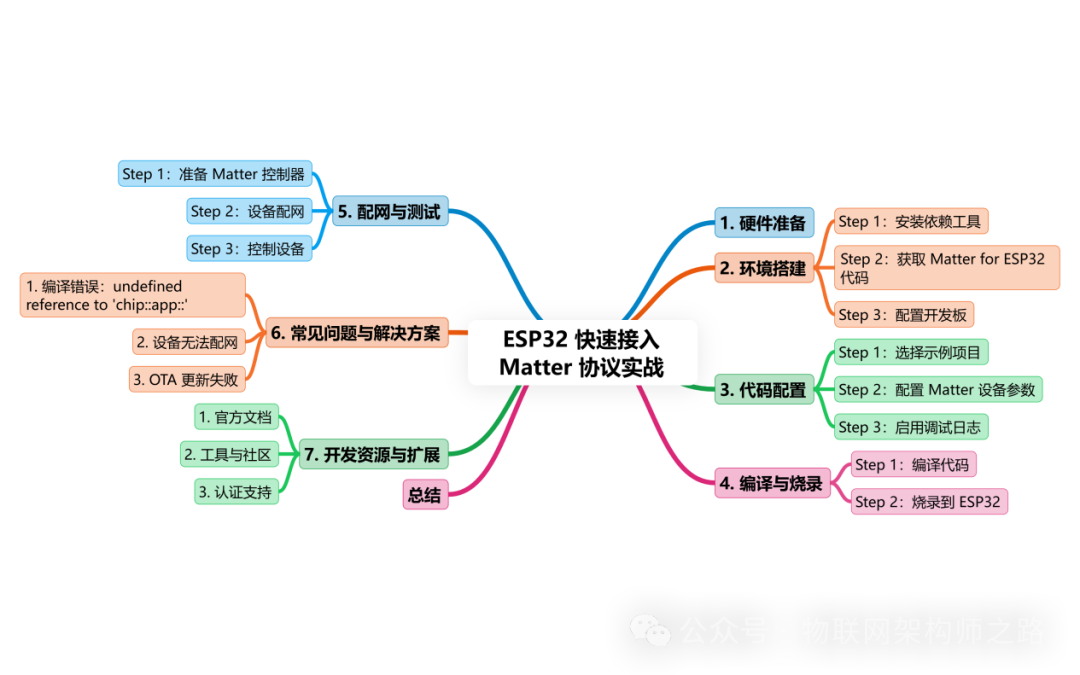
|
The following are the detailed steps for quickly accessing the Matter protocol with ESP32, covering environment setup, code configuration, compilation and flashing, and testing and validation, helping developers quickly implement Matter functionality on ESP32 devices: |
1. Hardware Preparation
•Recommended Development Boards:
○ESP32-S3-BOX: Integrated touchscreen and sensors, supports Matter over Wi-Fi.
○ESP32-WROOM-32: Basic model, requires an external Wi-Fi module.
•Network Environment:
○Must connect to a Wi-Fi network (for Matter over Wi-Fi).
○Or a network supporting Thread (requires additional configuration of a Thread border router).
2. Environment Setup
Step 1: Install Required Tools
•Operating System: Linux/macOS/Windows (recommended Ubuntu 20.04+).
•Toolchain:
○Python 3.8+: Used for ESP-IDF scripts.
○Git: Used to clone the code repository.
○ESP-IDF Toolchain:
|
Bash # Install ESP-IDF (using Ubuntu as an example) git clone -b v5.0 https://github.com/espressif/esp-idf.git cd esp-idf ./install.sh source ./export.sh |
Step 2: Obtain Matter for ESP32 Code
•Clone the ESP Matter repository:
|
Bash git clone –recursive https://github.com/espressif/esp-matter cd esp-matter |
Step 3: Configure the Development Board
•Select the Development Board:
|
Bash # Using ESP32-S3-BOX as an example idf.py set-target esp32s3 |
3. Code Configuration
Step 1: Select Example Project
•Navigate to the example directory:
|
Bash cd examples/lighting-app |
Step 2: Configure Matter Device Parameters
•Edit prj.conf:
|
TOML # Configure Wi-Fi SSID and password CONFIG_ESP_MATTER_WIFI_SSID=”YourWiFiSSID” CONFIG_ESP_MATTER_WIFI_PASSWORD=”YourWiFiPassword” # Configure Matter device information (e.g., Vendor ID, Product ID) CONFIG_ESP_MATTER_VENDOR_ID=65521 CONFIG_ESP_MATTER_PRODUCT_ID=1 |
Step 3: Enable Debug Logging
•Enable log output in menuconfig:
|
Bash idf.py menuconfig |
○Go to Component config → ESP Matter → Enable Enable debug logging.
4. Compilation and Flashing
Step 1: Compile the Code
|
Bash idf.py build |
Step 2: Flash to ESP32
|
Bash idf.py flash idf.py monitor # Monitor serial output |
5. Network Configuration and Testing
Step 1: Prepare the Matter Controller
•Recommended Tools:
○Raspberry Pi as a border router: Runs OpenThread Border Router.
○Matter Controller (Raspberry Pi or Linux):
|
Bash # Install Matter Controller git clone https://github.com/project-chip/connectedhomeip cd connectedhomeip ./scripts/bootstrap.sh ./scripts/examples/gn_build_all.sh |
Step 2: Device Network Configuration
1.Start the Matter Controller:
|
Bash ./out/standalone/linux/clang/debug/chip-all-clusters-app |
2.Discover the ESP32 device:
|
Bash chip-tool pairing on-network 1234 0x1122 20202021-06-05T12:00:00Z 1 |
○1234: Device node ID (set according to output).
○0x1122: Manufacturer ID (default value for ESP32).
Step 3: Control the Device
|
Bash # Read bulb status chip-tool on/off get on-off 1234 1 # Command to turn on the light chip-tool on/off on 1234 1 |
6. Common Issues and Solutions
(1) Compilation Error:undefined reference to ‘chip::app::
•Cause: ESP-IDF version is incompatible with Matter SDK.
•Solution:
|
Bash # Update ESP-IDF to v5.0+ git clone -b release/v5.0 https://github.com/espressif/esp-idf.git |
(2) Device Cannot Connect to Network
•Cause: Incorrect Wi-Fi configuration or Matter controller not started correctly.
•Solution:
○Check Wi-Fi SSID and password in prj.conf.
○Ensure the Matter controller and ESP32 are on the same network.
(3) OTA Update Failed
•Cause: Firmware signature or insufficient storage space.
•Solution:
○Use espsecure.py to sign firmware:
|
Bash espsecure.py sign_data –keyfile private_key.pem –output signed_firmware.bin firmware.bin |
7. Development Resources and Extensions
(1) Official Documentation
•ESP32 Matter Example Code: ESP-Matter GitHub Examples
(2) Tools and Community
•ESP-IDF Tools: Supports cross-platform development and debugging.
•ESP32 Community Forum: ESP32 Forum
(3) Certification Support
•Matter Certification Process:
○Apply for laboratory testing through the CSA official website.
Conclusion
By using ESP32 + Matter SDK, developers can quickly achieve Matter smart device development:
•Environment Setup: Depends on ESP-IDF and Matter for ESP32 repository.
•Core Steps: Configure Wi-Fi parameters, compile and flash, network configuration testing.
•Extension Directions: Add sensor functionality, optimize OTA update process.